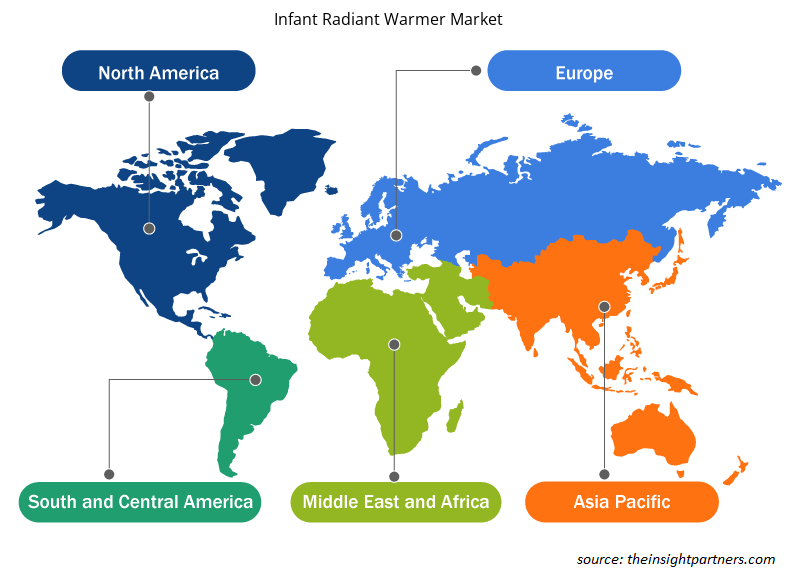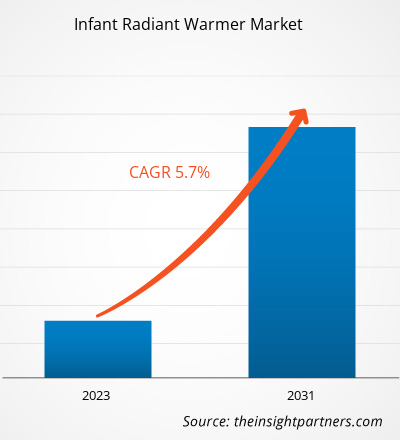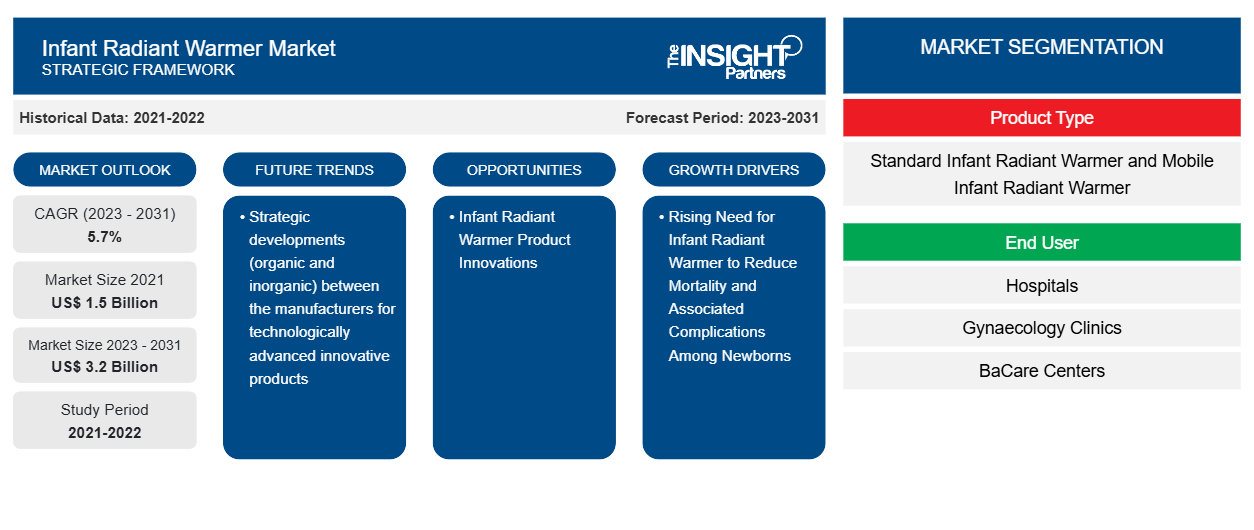El mercado de calentadores radiantes para bebés se valoró en 1500 millones de dólares en 2021 y se espera que alcance los 3200 millones de dólares en 2031. Se espera que el mercado registre una CAGR del 5,7 % entre 2023 y 2031. Es probable que los desarrollos estratégicos (orgánicos e inorgánicos) entre los fabricantes de productos innovadores tecnológicamente avanzados sigan siendo tendencias clave del mercado de calentadores radiantes para bebés.
Análisis de mercado de calentadores radiantes para bebés
Necesidad creciente de una cama radiante para bebés a fin de reducir la mortalidad y las complicaciones asociadas entre los recién nacidos
Para la salud inmediata y a largo plazo de los recién nacidos, es importante mantenerlos dentro de un rango de temperatura normal después del parto para su salud a largo plazo. Por ejemplo, las investigaciones científicas revelan que los recién nacidos a término con una primera temperatura inferior a 96,80 F tienen un alto riesgo de sufrir problemas respiratorios y niveles bajos de azúcar en sangre. Además, los bebés prematuros con bajas temperaturas son más susceptibles a infecciones, problemas respiratorios y complicaciones relacionadas con el azúcar en sangre que pueden durar varios meses. Por lo tanto, para mantener la temperatura corporal y, en última instancia, reducir la mortalidad, existe una demanda acelerada de calentadores radiantes para bebés que impulsará el crecimiento del mercado durante 2021-2031.
Descripción general del mercado de calentadores radiantes para bebés
La tecnología, la innovación y las soluciones tecnológicas inteligentes como esta siguen influyendo significativamente en el mercado de calentadores radiantes para bebés. La creciente necesidad de calentadores radiantes para bebés para reducir la mortalidad y las complicaciones asociadas entre los recién nacidos y los avances tecnológicos son los factores más influyentes responsables del crecimiento del mercado de calentadores radiantes para bebés. Las pruebas y dispositivos de diagnóstico innovadores son una tendencia clave para el crecimiento del mercado de calentadores radiantes para bebés. Los desarrollos estratégicos (orgánicos e inorgánicos) entre los fabricantes de productos innovadores tecnológicamente avanzados brindarán una oportunidad de mercado lucrativa para el crecimiento del mercado de calentadores radiantes para bebés.
Personalice este informe según sus necesidades
Obtendrá personalización en cualquier informe, sin cargo, incluidas partes de este informe o análisis a nivel de país, paquete de datos de Excel, así como también grandes ofertas y descuentos para empresas emergentes y universidades.
-
Obtenga las principales tendencias clave del mercado de este informe.Esta muestra GRATUITA incluirá análisis de datos, desde tendencias del mercado hasta estimaciones y pronósticos.
Calentadores radiantes para bebés Factores impulsores y oportunidades del mercado
Los avances tecnológicos en los calentadores radiantes para bebés favorecen el mercado
Los avances tecnológicos en los calentadores radiantes para bebés se encuentran entre los factores más influyentes responsables del crecimiento del mercado. El "Lullaby Warmer" de GE Healthcare es un ejemplo de un calentador radiante para bebés tecnológicamente avanzado. Por ejemplo, Lullaby Warmer tiene tecnología de microprocesador e ingeniería inteligente que crea una cama cálida constante para bebés con monitores incorporados que notifican a los cuidadores sobre eventos de temperatura críticos. Además, Lullaby Warmer incluye un innovador protector de sonda que ayuda a evitar que la sonda de piel se desprenda del bebé y ayuda a reducir el riesgo de sobrecalentamiento debido a la falta de monitoreo de temperatura. Además, Lullaby Warmer tiene una alarma de "verificar bebé" que suena si la temperatura de la piel del bebé se desvía en +10 °C del punto establecido. La unidad deja de calentar la temperatura si excede el valor deseado en 10 °C.impactful factors responsible for market growth. GE Healthcare's "Lullaby Warmer" is an example of a technologically advanced infant radiant warmer. For example, Lullaby Warmer's has microprocessor technology and intelligent engineering that create a consistently warm bed for babies with built-in monitors notifying caregivers of critical temperature events. Additionally, the Lullaby Warmer includes an innovative probe guard that helps prevent the skin probe from becoming detached from the baby and helps reduce the risk of overheating due to a lack of temperature monitoring. Further, Lullaby Warmer has a "check baby" alarm that sounds if the baby's skin temperature deviates by +10C from the set point. The unit stops heating the temperature if it exceeds the desired value by 10C.
Innovaciones en productos de calentadores radiantes para bebés: una oportunidad
Las innovaciones de producto, como las funciones de pantalla táctil, se encuentran entre las innovaciones de las cunas térmicas radiantes para bebés. La cuna térmica para bebés 2085 COLOR de Ampla es la solución más completa, avanzada y versátil para salas de parto, unidades de terapia intensiva, atención de urgencias, salas de hospital y quirófanos. Las principales características incluyen un "Panel táctil a color" y una interfaz fácil de usar. El dispositivo proporciona 3 funcionalidades, como "Tres modos de calentamiento". Estos modos de calentamiento incluyen Pre, Control servo, Manual, oxímetro de pulso SpO2 integrado, báscula neonatal, radiografías, ajuste de altura ergométrico e iluminación auxiliar.
Las innovaciones de productos de calentadores radiantes para bebés incluyen el 'Calentador radiante para bebés con cajones inferiores NEO 310'. Los calentadores de cuidados intensivos neonatales de la serie NEO 310 de Neokraft son sistemas avanzados controlados por servocontrol basados en microprocesadores con una función de seguridad de corte de alta temperatura. El producto incluye un controlador de temperatura controlado por servocontrol basado en microprocesador , modos con control de piel/aire y manual con pantalla LCD y un sensor de alta temperatura independiente para corte de alta temperatura a 39 grados. Por lo tanto, las innovaciones de productos en calentadores radiantes para bebés son uno de los factores más influyentes responsables del crecimiento del mercado.
Calentador radiante para bebés
Análisis de segmentación de informes de mercado
Los segmentos clave que contribuyeron a la derivación del análisis del mercado de calentadores radiantes para bebés son la candidatura y los servicios.
- Según el tipo de producto, el mercado de calentadores radiantes para bebés se divide en calentadores radiantes para bebés estándar y calentadores radiantes para bebés móviles. El segmento de calentadores radiantes para bebés estándar podría tener una mayor participación de mercado en 2023.
- Según el usuario final, el mercado de calentadores radiantes para bebés se divide en hospitales, clínicas de ginecología, centros de cuidado infantil y otros. El segmento de hospitales puede tener una mayor participación de mercado en 2023.
Análisis de la cuota de mercado de calentadores radiantes para bebés por geografía
El alcance geográfico del informe de mercado de calentadores radiantes para bebés se divide principalmente en cinco regiones: América del Norte, Asia Pacífico, Europa, Medio Oriente y África, y América del Sur/América del Sur y Central.
América del Norte ha dominado el mercado de calentadores radiantes para bebés. En América del Norte, Estados Unidos representa una participación considerable en el mercado de calentadores radiantes. La presencia de las principales empresas de dispositivos médicos en Estados Unidos, las intervenciones terapéuticas y los desarrollos estratégicos inorgánicos de los fabricantes son los factores más influyentes responsables del crecimiento del mercado. Se prevé que Asia Pacífico crezca con la CAGR más alta en los próximos años.
Calentador radiante para bebés
Perspectivas regionales del mercado de calentadores radiantes para bebés
Los analistas de Insight Partners explicaron en detalle las tendencias y los factores regionales que influyen en el mercado de calentadores radiantes para bebés durante el período de pronóstico. Esta sección también analiza los segmentos y la geografía del mercado de calentadores radiantes para bebés en América del Norte, Europa, Asia Pacífico, Oriente Medio y África, y América del Sur y Central.

- Obtenga los datos regionales específicos para el mercado de calentadores radiantes para bebés
Alcance del informe de mercado de calentadores radiantes para bebés
| Atributo del informe | Detalles |
|---|---|
| Tamaño del mercado en 2021 | 1.500 millones de dólares estadounidenses |
| Tamaño del mercado en 2031 | US$ 3.2 mil millones |
| CAGR global (2023 - 2031) | 5,7% |
| Datos históricos | 2021-2022 |
| Período de pronóstico | 2023-2031 |
| Segmentos cubiertos |
Por tipo de producto
|
| Regiones y países cubiertos |
América del norte
|
| Líderes del mercado y perfiles de empresas clave |
|
Densidad de actores del mercado de calentadores radiantes para bebés: comprensión de su impacto en la dinámica empresarial
El mercado de calentadores radiantes para bebés está creciendo rápidamente, impulsado por la creciente demanda de los usuarios finales debido a factores como la evolución de las preferencias de los consumidores, los avances tecnológicos y una mayor conciencia de los beneficios del producto. A medida que aumenta la demanda, las empresas amplían sus ofertas, innovan para satisfacer las necesidades de los consumidores y aprovechan las tendencias emergentes, lo que impulsa aún más el crecimiento del mercado.
La densidad de actores del mercado se refiere a la distribución de las empresas o firmas que operan dentro de un mercado o industria en particular. Indica cuántos competidores (actores del mercado) están presentes en un espacio de mercado determinado en relación con su tamaño o valor total de mercado.
Las principales empresas que operan en el mercado de calentadores radiantes para bebés son:
- Natus Medical Incorporated,
- Atención sanitaria de GE,
- Fisher & Paykel Salud Limitada,
- Niza Neotech Medical Systems Pvt. Ltd.,
- Sistemas médicos Phoenix (P) Ltd,
- Fantasía,
Descargo de responsabilidad : Las empresas enumeradas anteriormente no están clasificadas en ningún orden particular.

- Obtenga una descripción general de los principales actores clave del mercado de calentadores radiantes para bebés
Calentador radiante para bebésNoticias del mercado y novedades recientes
El mercado de calentadores radiantes para bebés se evalúa mediante la recopilación de datos cualitativos y cuantitativos posteriores a la investigación primaria y secundaria, que incluye publicaciones corporativas importantes, datos de asociaciones y bases de datos. A continuación, se incluye una lista de los desarrollos en el mercado de calentadores radiantes para bebés y las estrategias:
- En agosto de 2019, el Hospital UMass Memorial HealthAlliance anunció la recaudación de 260 000 dólares estadounidenses para proporcionar recursos adicionales para comprar cinco calentadores radiantes.
Informe de mercado sobre calentadores radiantes para bebés: cobertura y resultados
El informe “Tamaño y pronóstico del mercado de calentadores radiantes para bebés (2021-2031)” proporciona un análisis detallado del mercado que cubre las siguientes áreas:
- Tamaño del mercado y pronóstico a nivel global, regional y nacional para todos los segmentos clave del mercado cubiertos bajo el alcance
- Dinámica del mercado, como impulsores, restricciones y oportunidades clave
- Principales tendencias futuras
- Análisis detallado de las cinco fuerzas de Porter y PEST y FODA
- Análisis del mercado global y regional que cubre las tendencias clave del mercado, los principales actores, las regulaciones y los desarrollos recientes del mercado.
- Análisis del panorama de la industria y de la competencia que abarca la concentración del mercado, el análisis de mapas de calor, los actores destacados y los desarrollos recientes
- Perfiles detallados de empresas
- Análisis histórico (2 años), año base, pronóstico (7 años) con CAGR
- Análisis PEST y FODA
- Tamaño del mercado, valor/volumen: global, regional y nacional
- Industria y panorama competitivo
- Conjunto de datos de Excel
Informes recientes
Testimonios
Razón para comprar
- Toma de decisiones informada
- Comprensión de la dinámica del mercado
- Análisis competitivo
- Información sobre clientes
- Pronósticos del mercado
- Mitigación de riesgos
- Planificación estratégica
- Justificación de la inversión
- Identificación de mercados emergentes
- Mejora de las estrategias de marketing
- Impulso de la eficiencia operativa
- Alineación con las tendencias regulatorias























 Obtenga una muestra gratuita para - Mercado de calentadores radiantes para bebés
Obtenga una muestra gratuita para - Mercado de calentadores radiantes para bebés